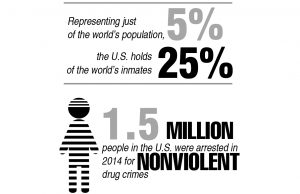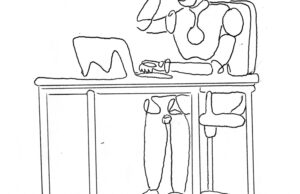A Nation of Incarceration: Too many inmates in the land of the free
For a country built on the principle of freedom, the United States keeps a disproportionately high number of its people behind bars. In fact, despite representing only five percent of the world’s population, the U.S. holds a quarter of the world’s total number of inmates and spends around $80 billion every year on the prison system – a system which is now being crushed under its own weight.
This trend of mass incarceration costs every state money that does not need to be spent, especially when inmates are serving time for nonviolent drug offenses and costing the government between 20,000 and 50,000 dollars every year.
California is not exempt from the financial drawbacks of mass incarceration. In the 2013-2104 fiscal year, California spent 9 percent of its General Funds money for corrections and rehabilitation – a total of almost 9 billion dollars for that year.
In 2011, California’s prisons were in such disorder that the Supreme Court ruled that the state was breaking the 8th Amendment, which forbids the use of cruel and unusual punishment. In 2014, an investigation of the Stockton Prison’s health center found that inmates had been left overnight laying in their own feces and nurses tended to ignore inmate’s call buttons, which led to the death of one injured prisoner.
In his written opinion, Supreme Court Justice Anthony Kennedy wrote that “the State’s prisons had operated at around 200% of design capacity for at least 11 years” and “as many as 54 prisoners may share a single toilet.”
The prisons have become breeding grounds for resentment and violence instead of rehabilitation, primarily because with all the available space being used for housing inmates, there is none for remedial purposes. In a gymnasium attached to one Californian prison which was made into a barrack to house inmates, the tight quarters led to a violent argument which escalated to the beating and death of one of the inmates. Because of the lack of correctional officers, the body was not discovered for several hours.
To help alleviate the stress on the state’s prison system, California’s Proposition 47 was passed with 58 percent of the vote in 2014. Under Proposition 47, nonviolent drug offenses and crimes such as thefts or forgeries of under 950 dollars in value are changed from felonies to misdemeanors. This could potentially allow for the release of thousands of inmates and a much needed relaxing of incarceration rates, especially since the United States is a country in which close to 50% of its inmates are held for drug related crimes.
Prop 47 will not solve all the problems in California’s prison system, but it does provide a starting point. Going forward, California lawmakers must keep an eye on rising incarceration rates. With less money being spent every year on keeping nonviolent inmates, money can also be spent on rehabilitation programs so ex-cons do not commit more crimes and return to prison, an occurrence known as recidivism.
To keep prisons from overcrowding and overburdening the state, nonviolent drug related offenses should be viewed as mental health problems rather than criminal offenses. This way, instead of spending time in prison, potential inmates can be directed to rehabilitation centers and be directed towards progress, rather than punishment.
Violent crimes in which people are put in danger should remain felonies for which criminals receive appropriately longer sentences. These violent criminals are what the prison system was put in place for, and allows the government to protect its citizens. But prisons cannot just be a place for punishment. They must be used correctly and effectively as tools to better society and the people in it, and this begins with being able to distinguish bad choices from bad people.




